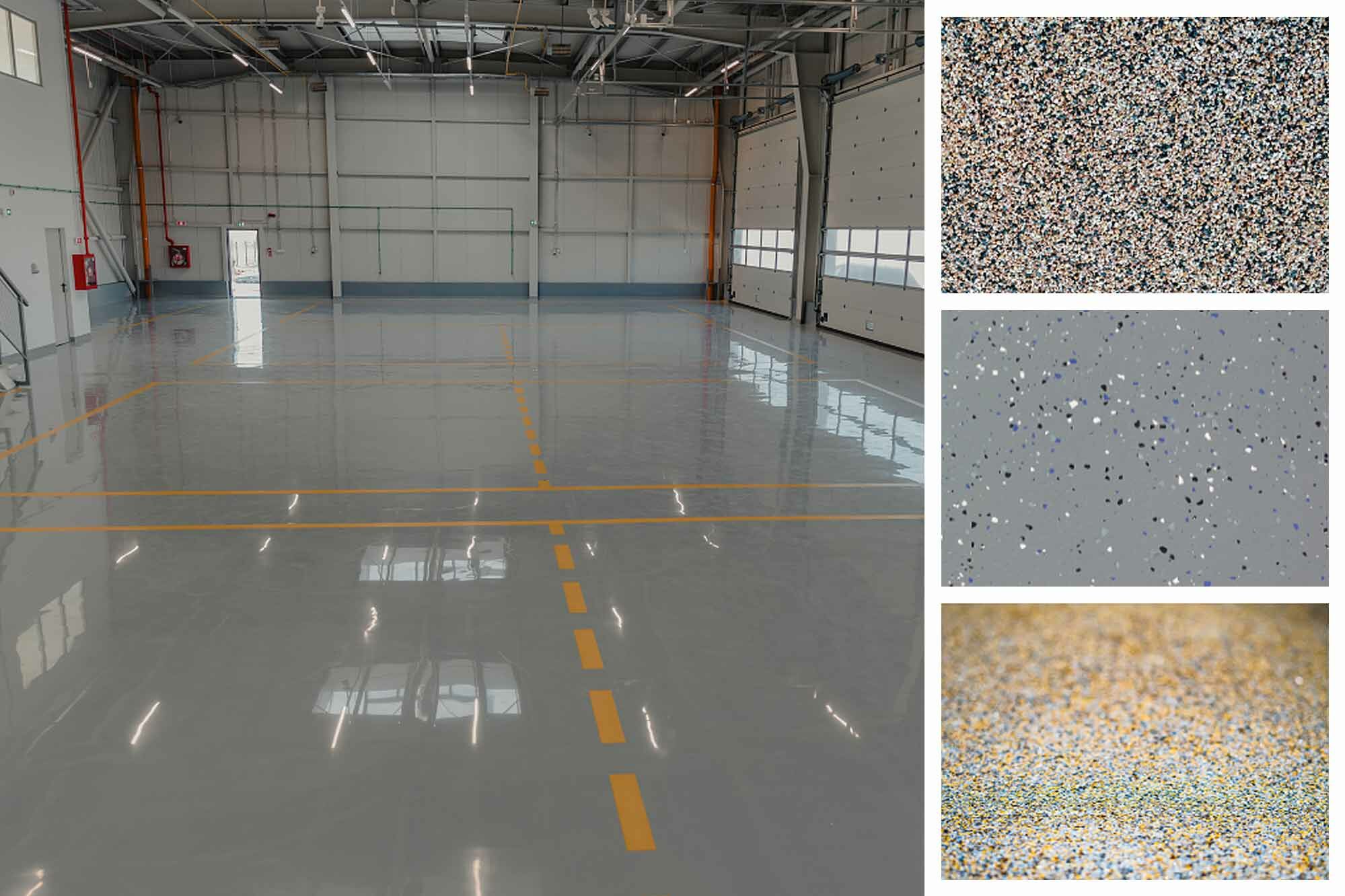An epoxy floor should typically be around 2-3 millimeters thick. Epoxy floors are a popular choice for commercial and industrial settings due to their durability, resistance to chemicals, and ease of maintenance.
Installing an epoxy floor with the appropriate thickness is crucial to ensure its longevity and performance. Epoxy floors provide a seamless and glossy finish, which can enhance the aesthetic appeal of any space. The thickness of the epoxy coating determines its strength and ability to withstand heavy traffic and impact.
A thinner coat may not provide sufficient protection, while a thicker coat may be unnecessary and costly. Finding the right balance in thickness is important to achieve the desired results and ensure the longevity of the epoxy floor. We will explore the factors that influence the thickness of an epoxy floor and provide guidelines for determining the appropriate thickness for different applications.
Importance Of Epoxy Floors
Epoxy floors are an essential element in various industries, thanks to their high durability and strength. These floors are designed to withstand heavy foot traffic, equipment, and machinery, making them highly resistant to chemicals, impact, and abrasion. The seamless and non-porous nature of epoxy floors not only enhances their performance but also makes them easy to clean and maintain. Additionally, epoxy floors are available in a wide range of colors and finishes, allowing businesses to choose a style that complements their brand and enhances the aesthetic appeal of their facilities. With their ability to withstand harsh environments, provide a smooth and visually appealing surface, and offer superior protection, epoxy floors have become the go-to choice for industries where a reliable and attractive flooring solution is essential.
Exploring Optimal Thickness For Epoxy Floors
When determining the optimal thickness for epoxy floors, several factors need to be considered. The first factor is foot traffic and usage. Epoxy floors in high-traffic areas such as commercial spaces or warehouses may require a thicker coating to withstand the heavy wear and tear. The second factor is load-bearing requirements. Depending on the type of equipment or machinery being used, the epoxy floor may need to be thicker to support the weight and prevent cracking or damage. Lastly, the condition of the substrate is crucial in determining the thickness. If the substrate has imperfections or is uneven, a thicker epoxy coating can help level the surface and provide better adhesion. Overall, it is essential to assess these factors carefully to ensure that the epoxy floor is applied at the appropriate thickness for long-lasting performance.
Assessing Typical Thickness Ranges For Epoxy Floors
Assessing the thickness of an epoxy floor is crucial to ensure its durability and performance. For light to medium-duty applications, the standard thickness range typically falls between 2 to 3 millimeters. This thickness provides sufficient protection against daily wear and tear, as well as chemical spills or mild impact.
In heavy-duty and industrial settings, it is important to consider the specific requirements of the facility. For areas with high foot or vehicle traffic, 3 to 6 millimeters of epoxy coating may be necessary to withstand the heavy load. Additionally, for environments that involve heavy machinery or potential chemical exposure, a thicker coating, often exceeding 6 millimeters, may be recommended.
When considering the thickness for specific applications, factors such as the nature of the facility, the type of activities performed, and any specific regulations or safety requirements should be taken into account. Consultation with epoxy flooring professionals can provide valuable insights into determining the ideal thickness for your specific needs.

Evaluating Foot Traffic And Usage
Understanding how thick an epoxy floor should be is essential when evaluating foot traffic and usage in your space. Analyzing the level of foot traffic your space receives is a crucial factor in determining the appropriate thickness for your epoxy floor. High foot traffic areas such as commercial spaces, warehouses, or industrial facilities require a thicker epoxy coating to withstand daily wear and tear.
For areas with heavy foot traffic, a thicker epoxy floor coating of at least X inches is recommended. This will provide an extra layer of protection and durability to ensure the floor can withstand frequent use and potential impacts from heavy equipment or machinery. It’s important to consider the type of activities that will take place in the space and the weight of vehicles or equipment that may be present.
Medium to light foot traffic areas, such as residential garages or offices, may require a thinner epoxy floor coating of around Y inches. While these spaces may not experience as much wear and tear, it’s still important to provide a level of protection against daily use and potential spills or stains.
Ultimately, the key is to assess the level of foot traffic and usage your space will experience, and then consult with a professional to determine the appropriate thickness for your epoxy floor. By doing so, you can ensure a long-lasting and durable flooring solution that meets your specific needs.
Understanding Load-bearing Requirements
Understanding the load-bearing requirements for an epoxy floor is crucial to ensure its durability and longevity. One important aspect is identifying the weight-bearing capacity of the floor. This can be determined by considering various factors, such as the type of epoxy used, the thickness of the floor, and any specific load requirements.
Assessing the potential load exerted by equipment and machinery is another crucial step. Knowing the weight and distribution of the machinery, as well as its frequency of use, can help determine the load-bearing capacity of the floor. It’s important to ensure that the floor can handle the weight without any risk of cracking or damage.
In addition to machinery, other factors like the type of space and its purpose should also be taken into account. Different areas, such as warehouses or garages, might require different load-bearing capacities depending on their usage and the types of materials or goods stored.
| Epoxy Floor Thickness | Load-Bearing Capacity |
|---|---|
| 2-3mm | Light-duty applications, such as residential garages or retail spaces |
| 4-6mm | Medium-duty applications, including commercial or industrial spaces with moderate foot traffic and occasional moderate to heavy equipment use |
| 6-9mm+ | Heavy-duty applications, such as warehouses or manufacturing plants with heavy machinery, forklift traffic, or high impact loads |
By understanding the load-bearing requirements specific to your epoxy floor, you can ensure that it is thick enough to withstand the expected weight and usage. This will help minimize the risk of damage or failures, and ultimately provide a long-lasting and reliable flooring solution.
Considering Substrate Condition
Addressing existing imperfections or damage prior to epoxy application: Before applying an epoxy floor coating, it is essential to address any existing imperfections or damage on the substrate. This includes repairing cracks, filling in holes, and leveling uneven areas. Any structural issues should be resolved to ensure a smooth and solid surface for the epoxy to adhere to.
Examining moisture levels and substrate porosity: Moisture levels and substrate porosity should be thoroughly examined before applying an epoxy floor. Excessive moisture can lead to delamination and blistering of the epoxy coating, while a substrate with high porosity will require more epoxy material to achieve the desired thickness. Testing the moisture content and porosity of the substrate can help determine the appropriate preparation and application techniques required for a successful epoxy flooring installation.
Residential And Commercial Epoxy Floors
When it comes to epoxy floors, finding the right thickness is crucial for both residential and commercial settings. For homes, offices, and retail spaces, it is recommended to have an epoxy floor with a thickness of at least 2-3 millimeters. This thickness provides enough durability to withstand regular foot traffic and minor impacts. Additionally, it ensures longevity and minimizes the risk of any cracks or damages.
Moreover, a thicker epoxy floor may be required for areas that experience heavier use or need extra protection, such as warehouses or industrial facilities. In such cases, a thickness of 3-5 millimeters or more might be necessary to handle the high demands and potential for heavy equipment.
In conclusion, balancing aesthetic appeal with functional durability is key when determining the thickness of an epoxy floor. By considering the specific needs of the space and the expected level of traffic, you can ensure that your epoxy floor provides the strength and longevity needed to withstand daily wear and tear.
Industrial Epoxy Floors
When choosing the thickness of an epoxy floor for industrial environments, several factors need to be considered. Specifically, the requirements for heavy machinery and constant movement play a crucial role in establishing a robust thickness. It is imperative to ensure that the epoxy floor is able to withstand the weight and impact of heavy machinery without cracking or chipping.
A thicker epoxy floor can provide better protection against wear and tear, as well as resistance to chemical spills and abrasion. Additionally, a thicker coating can offer enhanced durability and longevity, reducing the need for frequent repairs or replacements.
Moreover, a thicker epoxy floor can also provide better insulation properties, helping to regulate temperature and reduce energy consumption. This is particularly important in industrial environments where temperature control is necessary.
In conclusion, selecting the appropriate thickness for an epoxy floor in an industrial setting is crucial to ensure its performance, durability, and ability to withstand heavy machinery and constant movement.
Hospitality And Healthcare Epoxy Floors
The ideal thickness for epoxy floors in high-traffic areas, particularly in hospitality and healthcare settings, is crucial for durability and cleanliness. These floors are subjected to heavy foot traffic, constant cleaning, and exposure to various chemicals and substances. To ensure compliance with cleanliness and hygiene standards, a thickness range of 3-4 millimeters is recommended for these floors.
Thicker epoxy floors provide better resistance against wear and tear, impact, and abrasion. They also offer improved chemical resistance, making them suitable for areas that require regular cleaning and disinfection. Additionally, a thicker coating can help level uneven surfaces and provide a smoother finish, aiding in maintenance and hygiene.
By selecting the appropriate thickness, establishments can address the specific needs of their high-traffic areas while promoting cleanliness, safety, and longevity. Proper installation techniques and regular maintenance further contribute to the overall performance and lifespan of the epoxy floors.
Frequently Asked Questions For How Thick Should An Epoxy Floor Be
How Thick Should An Epoxy Floor Be For A Garage?
A typical garage floor coated with epoxy should be around 2 to 3 millimeters thick. This thickness provides enough durability and protection for regular garage use, including parking cars and light maintenance activities. It also ensures longevity and resistance to wear and tear.
What Factors Determine The Ideal Thickness For An Epoxy Floor?
The ideal thickness for an epoxy floor depends on factors such as the type of facility, the expected level of traffic, and the specific needs of the space. High-traffic areas or heavy-duty industrial environments may require a thicker epoxy coating for added durability.
Consulting with professionals can help determine the optimal thickness for your specific requirements.
Can I Apply A Thicker Epoxy Floor Coating For Extra Protection?
While it is possible to apply a thicker layer of epoxy for increased protection, it is important to consider the practicality and limitations. Thicker coatings require longer curing times and may be more prone to cracking and peeling if not properly applied.
Consulting with experienced epoxy professionals can help determine the best approach for achieving the desired level of protection without compromising quality.
Conclusion
To summarize, the thickness of an epoxy floor plays a critical role in its durability and longevity. It is essential to consider factors such as the intended use, traffic intensity, and the condition of the substrate before determining the ideal thickness.
By adhering to industry guidelines and consulting with professionals, you can ensure that your epoxy floor meets the specific requirements of your application, providing you with a seamless and long-lasting flooring solution.




